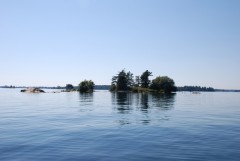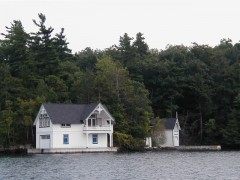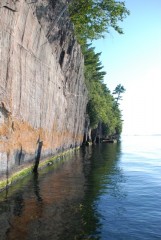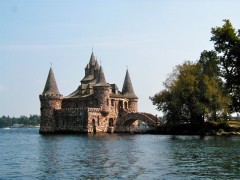The Thousand Islands
… a brief summary of a rich history
The Thousand Islands region of the St. Lawrence River is generally considered to consist of about the first 30 miles of the river as it begins its long journey from Lake Ontario to the ultimate destination of its entry to the Atlantic Ocean at the Gulf of St. Lawrence in Canada. Through the marvels of the terrain building glaciers of the last ice age and many thousands of years of water movement from the Great lakes to the ocean, the bedrock granite of the region that divides northern New York state from Canada has been carved to yield an amazing cluster of islands.
In fact, over 1,800 islands actually exist along with over 3,000 shoals. This assessment considers an island to be any land mass that is above the water for 356 days a year and supports the growth of at least one tree. The great majority of shoals in this stretch of the river are composed of granite and as most boaters are keenly aware, can be very hazardous or at least costly.
The native American tribes knew this region well and considered it to be most special for its enduring natural beauty and abundance of fish and other wildlife. The first white explorers were no less impressed and trappers soon followed the explorers who were in turn followed by settlers.
The region saw its share of turmoil as both Canada and the United States emerged from their colonial origins as independent democracies though the natural boundary of the great St. Lawrence River remained difficult to contest as the international border between the two countries.
The first steamboat wharf in Alexandria Bay was constructed in 1823 and by 1830 the small town consisted of about 12 wood framed homes. The region lay somewhat undiscovered until the mid 1800’s when the first islands went up for sale from Azariah Walton who originally owned all of the timber rights in the region. The first island to be sold was Meadow Island in 1854 (now known as Manhattan Island) for $40 to Mr. Seth Green, a well known naturalist with a particular interest in studying fish and their habitat. This was followed in the following two years by the sale six more islands which included Deer Island to Mr. Samuel Miller in 1856.
An era of great prosperity followed through to the turn of the century and the Thousand Islands region grew to be very popular among the wealthy from New York City and Philadelphia. The stretch of islands along the American channel of the river between Clayton and Alexandria Bay grew to be know as Millionaire’s Row. George Pullman, of the Pullman Railroad Car fame, built a small granite castle called Castle Rest and at one time entertained generals Sherman and Grant for a fishing expedition. George Bolt, hotel manager for John Astor, tore down a large wooden cottage to start construction of the now well know tourist attraction, Boldt’s Castle.
With the death of George Boldt’s wife in the early 1900’s it may be thought that a slow but steady demise of the region had begun. Boldt, in mourning, ceased work on the castle and it was never to be completed. The first world war was followed by financial declines and the great stock market crash leading up to the great depression. The millionaires, their cottages and the slow but elegant steamboats gave way first to bootleg liquor and then the faster pace of a restless country and the automobile.
Many grand cottages and hotels of the region burned accidentally while some, such as Pullman’s Castle Rest, were torn down intentionally by subsequent owners who could no longer justify the grand size of the houses or pay the large property tax bills. Some of these wonderful structures remain intact, somehow defying the tremendous change in the past 100 years. Those that now lie in ruin still have fascinating stories to tell.
Today, the Thousand Islands region has seen a steady rediscovery. Pleasure boaters and water enthusiasts of all types appear in number as the sun rises on a typical summer’s day. Even new homes are being built in a manner emulating the style first portrayed by the grand cottages over a hundred years in the past.






